Guide To Help Others Germinate Lettuce Seeds Successfully
Lettuce seeds can be one of the most difficult seeds to uniformly germinate due to thermodormancy and photodormancy. Lettuce will not germinate well if temps are too high or if seeds are in the dark. For a near 100% germination rate this is what I do.
1) Make sure lettuce seed is from this year. Lettuce seed loses its vigor within a year. This is often one of the unforeseen problems that handicap one's efforts right from the start.
2) If you make your own soilless mixes this is the recipe I use.
A) 1/4th perlite, 1/2 fine grade horticultural vermiculite, 1/4 peat moss.
If you don't make a soilless mix then you should just buy an organic potting mix that contains peat moss and perlite.
3) Keep temperatures between 70-85 degrees. Lettuce seed requires daily temps that are on the cooler side 55-75 is good to prevent bolting. To germinate the seeds however, the best temperatures are between 70-85. At these temps with the good seed and proper light I can get 10% germination in 18 hours and 98% germination in 48 hours.
4) Light is the most overlooked part of growing lettuce. Since lettuce is photodorment it will not germinate in the dark. It seems very difficult to think of a seed successfully germinating on the surface where the air is dry and the seed can dry out quickly. But that can be pretty easily overcome. For light sources you will want to place the plug tray, or whatever else you have used to put your soilless mix in under fluorescent lighting within an inch of the bulb or in a south facing window where the seeds get sunlight at least 3-4 hours a day.
Final preparation.
With your plug tray or flats, make sure the soil has been pressed down smoothly. Sprinkle lettuce seeds on top of the soil surface. Lightly press the seeds into the soil. Use a spray bottle or a garden hose on mist setting. Thoroughly soak the soil and seeds gently.
It is a common understanding of most growers not to over soak your soilless medium when germinating seeds. Generally this practice is applied because many seeds take 5-10 days to germinate and molds that can cause diseases such as the dreaded damping-off will have a much better chance at establishing themselves well before the seed can break the surface.
Lettuce is the exception. You soak the seed and you place saran wrap over the flat or tray you have the seed in. Place it under the light, keep temps between 70-85. After 1 day check the soil to make sure it is still saturated. If it looks to be drying up even a little, soak the entire surface again and recover. After 48 hours, open the flat or tray again and closely look at the lettuce seed. You should notice most seeds have split at the base where a very tiny root is breaking through. If you see that more than half of the seeds are like that, take the saran wrap off, spray with water to keep the surface wet while the seeds dig their roots into the soil. Once the roots are established enough after 3-4 days you can begin letting the soil dry out a little bit before watering again.
By allowing the soil to dry out a bit you will have changed the environment your seeds were in and if there was any fungus growing that could potentially damage your seedlings you will have slowed or stopped its growth by allowing the soil surface to dry out a bit. Now all that is left is to lightly water, keep under light, and wait 4-6 weeks to transplant into your garden. Don't forget to harden lettuce off. Even though it is a cold crop that can tolerate light frosts if it was grown in the house it still needs to be acclimated to the outdoors.
Comments (40)
calistoga_al ca 15 usda 9
11 years agolast modified: 9 years agoLettuce is one of the easiest of seeds to germinate and to grow. I can not prove it, but they seem to be 100% in my experience. Transplanting is also fool proof, they tolerate bare rooting without missing a beat. Even the seedlings I throw away, grow like weeds, just laying on top of the soil. Al
Related Professionals
Simpsonville Landscape Architects & Landscape Designers · Beavercreek Landscape Architects & Landscape Designers · Clark Landscape Architects & Landscape Designers · Glassmanor Landscape Architects & Landscape Designers · Pottstown Landscape Contractors · Huntley Landscape Contractors · Pikesville Landscape Contractors · Franklin Park Carpenters · Wrentham Carpenters · Chicago Heights Fence Contractors · Fair Oaks Fence Contractors · Modesto Fence Contractors · Newington Fence Contractors · Northridge Fence Contractors · Lomita Fence Contractorsmandolls
11 years agolast modified: 9 years agoI tried a few seeds of 6 different types of lettuce a couple of weeks ago. 3 types germinated quickly at 100% or near, 1 type Germinated at about 50% and 2 types didn't germinate at all.
Some of the seed was from last year, some from this year, but it was this year's seed that didnt germinate.
So...........my guess is that some lettuce is easier than others.
terryincs
11 years agolast modified: 9 years agothanks for the info. even tho i have been growing lettuce for years, i didn't realize that you needed to soak the soil and keep the seed in light. i just grew it like everything else and prob had about 70% germination. i will try for better this year. any hints for keeping the plants indoors for indoor harvest? just keep picking the larger leaves? at what size do you transplant and how big a pot is needed?
HayBerry
11 years agolast modified: 9 years agoThank you soulreaver. This is good and useful information.
soulreaver
Original Author11 years agolast modified: 9 years agoYou're welcome HayBerry.
Mandolls do you remember the conditions those seeds were planted under?
Terry, it depends on the lettuce type but I assume you are talking about loose leaf types and not head types. In that case if you want a continued harvest don't take more than 25-50% of the plants vegetative mass every week. Outer leaves should be under 4 inches for best flavor.
If you take too much at once the plant will get stressed. If you keep the plant small by taking the outer leaves on a weekly basis and keep the plants away from temps above 80 degrees you should be able to harvest the same lettuce for 4-6 weeks. All lettuce will eventually try to bolt around that time regardless of how well you take care of it.
Lettuce is a good plant to grow under fluorescent lights indoors. You will actually have better production under a light 14 hours a day than being in direct sun for 3-5 hours in a south facing window because lettuce prefers scattered light over direct sunlight especially when the temperatures get above 70 degrees.
Another thing you can do, if you see any of your lettuce plants starting to bolt, at the very first sign, or even if it is week 5 or 6 and nothing had bolted yet you can take a couple days to harden off your plants, then leave them all outside for a night if the temps will be around 34-45. Light frost causes lettuce and other leafy greens to taste sweeter because the plant produces more sugars to prevent tissue damage from the cold. The next day you can harvest everything and it will taste better.
Also always cut leaves or harvest heads in the morning before it gets warm. It keeps the plants crisper and it will help them last longer in the fridge if you don't plan to eat them right away.
mandolls
11 years agolast modified: 9 years ago"Mandolls do you remember the conditions those seeds were planted under?"
I germinated them inside, in a domed tray, sitting on top of fluorescent lights. The lights are on a set of shelves that is covered most of the time with a mylar blanket to hold in the heat, as the room is kept at about 60 degrees. The seed trays are 65-70 degrees there. The seed was sprinkled on top of moist starting mix, and then sprayed into the soil a bit with a mister.
I'll try a few on my top shelf which is warmer (I have germinated Begonias successfully there) and try saturating the soil a bit more and see if that helps the germination rate.
soulreaver
Original Author11 years agolast modified: 9 years agoMandolls it's odd that your seed from this year didn't germinate when your seed from the previous year did.
You said your trays were sitting on top of the fluorescent lights? Do you mean the trays were on top to get bottom heat and received no light?
The temp was a little on the low side for germination and that could easily have contributed to rotting in a moist environment. Germinating temperatures of 75-80 would speed up the rate of germination by days giving the seed much less time to rot.
calistoga_al ca 15 usda 9
11 years agolast modified: 9 years agoHaving lived for forty years in the Pajaro Valley of California where hundreds of acres of lettuce is grown, three crops a year being the norm, I just don't see the point of picturing it as a difficult operation. If your post is helpful to others, and is not a cause for discouragement, that is fine with me. Al
mandolls
11 years agolast modified: 9 years ago"Mandolls it's odd that your seed from this year didn't germinate when your seed from the previous year did.
You said your trays were sitting on top of the fluorescent lights? Do you mean the trays were on top to get bottom heat and received no light?"I have been testing different types of lettuce over the past three years to see what does well for me. I have had several types that seemed difficult to germinate, while others germinated really easily.
Seed that needs 65-75 degrees for germination I start on top of my fluorescent lamps for bottom heat. (in a room that is kept about 60 degrees) They get ambient light since I use the 2nd group of lamps from the top and there are 4 shelves of lights, but not direct light.
I start heat lovers on the very top shelf under lights where it is closer to 75-78. Until I read your post I had never seen anyone recommend that much heat and light for lettuce. I'll give it a try and see if it makes the difference.
RideauRambler
11 years agolast modified: 9 years agoThanks! This is great info as I was just about to try starting lettuce indoors for the first time. Especially found the saran wrap/when to remove/when to mist vs saturate/when to dry out part very helpful. Thanks so much for posting your knowledge :)
torontoem
10 years agolast modified: 9 years agoThank-you for this post! I'm surprised that someone would think germinating lettuce, or anything, frankly, would be so simple there needn't be detailed info online for how to do it. I appreciate the details. I'm a somewhat experienced gardener with many years of successful crops of many sorts, but have been struggling with my lettuce this spring. Your post helps.
My problem? I think it's my attempt to use up old seeds. They've worked superbly for things like kale, tomatoes, peppers, eggplant, etc., but lettuce is just not working. I have to go buy some new seed. This stuff is at least two or three years old. It worked last year with limited success; but this year, nothing. These ones have just been molding on me under my light set-up. Very frustrating. And even with experience we sometimes need a list to problem-solve. Thanks!runswithscissors
10 years agolast modified: 9 years agoI have planted my whole life, and I'm still an amateur because I learn new things every day about it...and in fact, I often have to learn the same things over and over. I did not know lettuce seeds needed soaked either. One never knows it all...
claydirt
10 years agolast modified: 9 years agoBumping this up to the top of the list (so I can find it again!).
Black Seeded Simpson has been easy for me. But that's where the magic ends. I may try germinating some other lettuce inside this season to see if I can do better. And I'll toss out my old seed while I'm at it. Thank you, soulreaver and others!
Francis112
10 years agolast modified: 9 years agoLike "Calistoga" said above, lettuce is one of the easiest plants to grow from seed. I have grown it all my life, and always have covered the seed with 1/8" to 1/4" of finely sifted soil, and it always germinates perfectly. I have never found that the seeds need light to germinate successfully.
Sorry to disagree on this item, but it does seem rather important. The instructions on the seed packets typically say to cover the seed also. The website below has an extensive section on growing lettuce from seed, and it also recommends covering the seed. Scroll down to the section on lettuce.
The advantages of covering are that it keeps the seeds moist for far longer, and this actually aids germination.
Here is a link that might be useful: French Intensive gardening method
alleneschell
10 years agolast modified: 9 years agoI have a lettuce (outside) that sprouted and has sent roots
down an amazing 3 " but doesn't seem to grow. It's staying small. Is this a temperature thing? We've had a cold spring, mostly in the 50's.dirtguy50 SW MO z6a
10 years agolast modified: 9 years agoStarting lettuce from seed has to be the easiest thing in the world to start. It's almost impossible to not get it to sprout. I am totally confused with this thread. KISS method works just fine. Just my opinion.
This post was edited by dirtguy50 on Fri, Apr 4, 14 at 22:11
lovelyother1
9 years agolast modified: 9 years agoI am puzzled as to why those that think this thread is pointless are even reading it posting here?
I appreciate this post. I am a fairly new gardener, in my third year of veggie gardening. I plant as much as I can in my limited space around my small, city backyard. To make it worth it, I need to get as much success as I can out of these small plantings, and therefore try my best to get it right the first time. I had great success last year with all of my crops, except for some reason, not with my leaf lettuce. This year, the seeds have sprouted and are under a florescent light, but the little seedlings have started laying down. They are just about a week old. As of now they are still green. Any thoughts on what is happening? Might I be over/under watering? Can I save them? Thanks in advance for your help!
This post was edited by lovelyother1 on Fri, May 2, 14 at 21:40
chuckurso1
9 years agolast modified: 9 years agoI have been growing for about my whole life, first in Illinois and then as a young guy in Florida, from 1991 til now. I find this thread a great find. I have had great luck with lettuce in South Florida mainly due to shade cloth and the right area's to put the plants. I was looking for germination times of Jericho lettuce and stumbled onto this. Soulreaver did a good thing by putting this info out here for beginners and also seasoned growers like myself who still doesn't think he knows it all. I am refining my lettuce growing techniques and want to know as much as possible on getting them growing fast so the health of the plant is maintained better. In South Florida the rules are much different and extremely challenging so you have to be on your game! Just a bit of advice for heat tolerance types. Try Bronze Megnonette (under shade cloth) for great flavor in a butterhead type.
There will always be people who are negative to spoil a good thing, we just have to bear with them and hope they find something else to occupy there time.Pyewacket
9 years agolast modified: 9 years agoThe problem with this post is that there is so much incorrect information in it.
1) Make sure lettuce seed is from this year. Lettuce seed loses its vigor within a year.
Incorrect. Lettuce seed can last up to 6 years if properly stored.
Iowa state seed viability table
Of course there are always the outliers, a few varieties that will exceed the average or will fail to meet it. But in the main, the vast majority of lettuce varieties seed will remain viable for much longer than one year - assuming you've properly stored it.
3) Keep temperatures between 70-85 degrees. Lettuce seed requires daily temps that are on the cooler side 55-75 is good to prevent bolting. To germinate the seeds however, the best temperatures are between 70-85. At these temps with the good seed and proper light I can get 10% germination in 18 hours and 98% germination in 48 hours.
This is also incorrect in its entirety. Lettuce PLANTS will bolt; lettuce SEED cannot bolt because it hasn't even sprouted yet. The temperature at which one should germinate seed is unrelated to the temperature at which lettuce will bolt, which is a range and varies from variety to variety anyway.
Also keep in mind these are SOIL temperatures, not air temps. It can be a lot hotter than 85F, but as long as SOIL temp is below that for even part of the day, lettuce won't necessarily bolt. One method of cooling soil is to mulch well. But that has not a thing to do with germination, so onward ...
The optimum germination temperature for the vast majority of lettuce seed is 70F to 75F. At 85F you will have 100% loss of your seed with some varieties; no variety of lettuce germinates well at temps above 80F.
Most seed mat thermostats won't click on until the temp has dropped 2.5F to 3F below whatever you set it at, so if you set your thermostat at 80F, it will spend most of its time actually lower than that. So setting your thermostat at 80F won't necessarily significantly reduce germination because that is the MAX the thermostat is aiming for.
Unless you are using a herp thermostat, which usually has only 0.1F variance instead of 3F. Then setting it at 80F and maintaining the heat at that level will reduce your germination rate.
However, lettuce seed will in fact germinate all the way down to 35F with 98% success, but the problem is that seedling emergence can be quite lengthy, over a month and a half.
See table labeled Percentage of Normal Vegetable Seedlings Produced at Different Temperatures
Near the freezing point, you get 98% germination but it takes 49 days for seedlings to emerge.
At 41F, you get 98% germination and it takes 15 days for seedlings to emerge.
At 50F, you get 98% germination and it takes 7 days for seedlings to emerge.
At 59F, you get 99% germination and it takes 4 days for seedlings to emerge.
At 68F, you get 99% germination and it takes 3 days for seedlings to emerge.
At 77F, you get 99% germination and it takes 2 days for seedlings to emerge.
At 86F, you get 12% germination and it takes 3 days for seedlings to emerge.
When you read that the "optimum germination temperature" for lettuce or any other crop is a certain range, they are referring to optimum for commercial growers and farmers, who don't want resources tied up for any longer than is necessary. So yeah, nominally germinating lettuce seed at 77F gets you your lettuce seedlings emerging in a mere 2 days, but for home gardeners, do we really care if it takes 3 days instead when it means we DON'T need to mess with a heating mat? That's a $50 investment for the first mat and a thermostat. Not necessary for lettuce or really much of anything else.
Optimal for home gardeners is to dispense with the heating mat. Soil temp in flats inside your house will be within 2 or 3 degrees of the ambient temp anyway, and very few people keep their houses below 59F. So your worst case scenario is that the seedlings will emerge in 3 or 4 days without the use of a heating mat and germination will still be 99% successful. If you're sprouting them in an unheated garage it might take a week or two, as long as temps are above 41F.
Lettuce really IS bulletproof. It takes absolutely no special knowledge or handling. Heat mats are absolutely not required. Save that for your eggplants. Even peppers don't really need a heat mat if started inside the house. You will rarely find a need for a heat mat unless you habitually start seed in an unheated area. I've been growing for over 40 years and only recently bought a heating mat to start some tropical seed (curry leaf plant). I've had good germination and emergence from everything I've ever grown without heat mats, including eggplants, because enough heat is generated by the fluorescent lights to bring the soil up to temp without broiling it.
As far as lettuce seed needing light to germinate - there are some seeds that do need light to germinate, but lettuce is not one of them.
There has been some research that indicates some varieties of lettuce will germinate better when exposed to SPECIFIC wavelengths in the red range; but given you're going to get 98% to 99% germination anyway (as long as you don't drown your seedlings and end up with damp-off, fungus, or rot), I don't think its very worthwhile to run out and buy expensive lights that will emit that particular wavelength and then make sure the seed is turned right way up so that the photoreceptive site on the seed isn't face-down in the dirt.
I strongly doubt that it makes any noticeable difference to the home gardener if the seed is exposed to fluorescent grow lights or sunlight filtered through a window, which may or may not include the specific wavelength that only some lettuce varieties seem to be sensitive to.
In this instance, follow the directions on the seedling packet. If it says cover the seed, cover the seed. If it says NOT to cover the seed, DON'T cover the seed. I can't recall ever growing a lettuce variety which instructed me not to cover the seed. Apparently it doesn't hurt it not to, but it isn't required, either.
Point 4 is also wrong in its entirety, for all the reasons detailed above.
"Final preparations" is fine, right up to the point where the OP suggest it is OK to soak your growing medium. Again, you may get away with this, but it is in no way necessary and does carry with it considerable risk, especially for the seed starting newbies that this post is ostensibly directed toward.
All you need is general good habits for seed starting. None of the rest of this - seed mats, worrying about soil temp, covering with saran wrap, exposing to light - is in the least bit necessary. Let me say it again:
LETTUCE IS PRETTY MUCH BULLETPROOF. Prepare your potting mix properly, firm it into your seed starting tray or plug or whatever, drop the lettuce seed on there and cover lightly (unless the seed packet says otherwise) - unless you over or under water, the seed will come up.
None of the rest of this elaborate method is necessary or even particularly helpful. You can do it this way if you want, but it amounts to a gardening ritual rather than a necessary practice.
If you think its super-cool to get lettuce seed to sprout in under 24 hours, by all means, have at. There's nothing wrong with that if that's what gives you your jollies. But it isn't necessary.
chuckurso1
9 years agolast modified: 9 years agoyou have a lot of mistakes yourself! peppers do not need a heat mat? maybe they will sprout eventually and maybe not, but wasted time for sure. Anything you grow is better off if started more quickly when indoors, too many disease issues, thats just common sense! As far as vigor, soulreaver is correct that fresh seed is always better. If you are saving your own seed, why would you use older seed anyway? If buying and you have older seed, then go for it, just start much earlier and take your chances. Lettuce seed at 6 years old will generally not germinate, I actually just tried some last year and again this year, it is almost impossible and I have yet to see it myself with lettuce seed. Tomatoes yes, sometimes, but you sure have to wait longer and that could throw off your season if time is of the essence. Try growing in Florida and then tell me how you feel about using older seed to germinate or not germinate.
Why are people wanting to attack this guy? it is such a waste of good time. Try put something up on here without slamming the guy!zzackey
9 years agolast modified: 9 years agoI used to enjoy learning from these sites. Too many back stabbers on lately. Everyone has different experiences and they should be able to share them without being put down. I know lots about some plants and very little about others. I am far from perfect. I never had good luck with lettuce growing and now I know why. I always buried the seeds and watered them in well and I kept watering them often. I didn't know about misting them. Can't we just share what we know and not get our shorts in a knot if someone posts a different way of doing something?
chuckurso1
9 years agolast modified: 9 years agoHello Zackey! you are so correct. Funny that you mentioned misting your seeds! I just misted mine for the night. What part of Georgia are you at? I have a home in Hiawassee!
zzackey
9 years agolast modified: 9 years agoI never misted mine. That was someone else. I live in St. George. What part of the state do you live in? I'm a Yankee transplant and I'm not familiar with much of Georgia.
Pyewacket
9 years agolast modified: 9 years agoyou have a lot of mistakes yourself! peppers do not need a heat mat? maybe they will sprout eventually and maybe not, but wasted time for sure.
No, peppers do not NEED a heat mat, but they will probably benefit if you have one. As I said - started under fluorescents inside your heated home where ambient temps are usually 70 to 74F, the soil is sufficiently warmed by the fluorescent fixtures that you don't really need a heat mat. My peppers have always come up just fine without a heat mat under these conditions. That said they'll probably come up a a day or two earlier if you have a heat mat - but you still don't really NEED a heat mat to start peppers, given that you're starting them in your heated home, under fluorescents (which at that point should be hanging very low to the surface of the planting medium, like a couple-three inches above the surface).
I don't see a couple of extra days to germinate with no extra losses as being wasted time, but YMMV.
Eggplant seeds are FAR more tender than peppers, and I start them routinely without a heat mat and have for 40 years. I get WAY higher germination rates than were reported in that paper I linked to, as well. I know for a fact I get close to 100% germination. Definitely over 90%. With no heat mat, inside a heated home, under fluorescents.
You need the fluorescents anyway once the seedlings emerge so I'm not sure what your issue is.
In any case, peppers and eggplants are not lettuce. Whether you agree or not with how I choose to start my peppers and eggplants, no argument can be made that a heat mat is necessary or even that helpful in getting lettuce seed to germinate - inside a heated home, under fluorescent lights.
Personally I will be starting my lettuce in the unheated garage this year, under fluorescent lights, with no heat mats. It'll take a couple of weeks, but that's fine with me. Saves space inside for other things that actually need the extra heat.
Anything you grow is better off if started more quickly when indoors, too many disease issues, thats just common sense!
I have no idea what you are talking about. At no point did I discuss starting anything outdoors. The merits or deficiencies of direct seeding are an entirely different discussion.
As far as vigor, soulreaver is correct that fresh seed is always better. If you are saving your own seed, why would you use older seed anyway? If buying and you have older seed, then go for it, just start much earlier and take your chances. Lettuce seed at 6 years old will generally not germinate, I actually just tried some last year and again this year, it is almost impossible and I have yet to see it myself with lettuce seed.
You can take it up with the University of Iowa - or was that Iowa State? I'm not going to argue that anyone should purposely save seed for 5 or 6 years and then expect to get 100% germination. But the fact remains that most varieties of lettuce seed are viable for much longer than a single year.
Of course fresh seed is always preferable, but I wouldn't throw out 3 year old lettuce seed without giving it a chance first. Again - YMMV. But there is no arguing the fact that lettuce seed is NOT always or even usually bad after the very first season.
So plant some old and some new. Plant extra. What's the worst that could happen - you put out twice as many plants and then you'll be forced to eat the tender, fresh, young thinnings in your salads for awhile, LOL!
Tomatoes yes, sometimes, but you sure have to wait longer and that could throw off your season if time is of the essence. Try growing in Florida and then tell me how you feel about using older seed to germinate or not germinate.
Again I have no idea where this is coming from. No one has at any point suggested that one should rely on old seed, particularly improperly stored seed. But I routinely keep seed for 3 years, sometimes longer, and have had no problem with any seed that isn't normally fragile or short lived.
I haven't grown in Florida, its true. But I have grown in Puerto Rico, and I'm not sure what your issue is. I didn't experience any more problems starting from seed there than I have any other place I've ever lived. Of course I kept my seed in a cool, dry place just as I always have. What any of this has to do with starting lettuce at home, I don't see.
Why are people wanting to attack this guy? it is such a waste of good time. Try put something up on here without slamming the guy!
No one has made a personal attack on the OP, although several personal attacks have been made against folks who have pointed out the erroneous nature of that first post.
The information provided by the OP is just plain wrong. None of that complicated process is necessary or even helpful to the novice grower, or to those of us who are more experienced but uninterested in going to such lengths to get our lettuce seed up a day or two earlier than normal.
It's great information if you want to speed-start lettuce seed, once the errors are corrected. But none of that is needed to start lettuce seed. It's really very simple and easy, and happens quite quickly enough on its own.
Pyewacket
9 years agolast modified: 9 years ago@zackey - you said
I never had good luck with lettuce growing and now I know why. I always buried the seeds and watered them in well and I kept watering them often. I didn't know about misting them.
Bottom watering is usually preferred for small seeds because top watering tends to wash the seed down into the medium. Lettuce should be covered, but thinly. Top watering often ends up burying small seed deeper and that reduces germination.
Misting is another way of preventing that from happening.
Also it is possible that when you were "watering them in well" you were inadvertently over-watering. Not to worry, it happens to all of us.
Misting your starts will also tend to reduce the risk of over-watering simply because it takes longer and gives your brain time to catch up with your hands, LOL!
I personally prefer to bottom water. Its just easier for me. But misting is just as acceptable. Lots of people top water without over-watering, but I'm not one of them most of the time. There are some things that I successfully top water to start but most things, not.
Right now I don't have any flats that allow me to properly bottom water, I only have drainage flats (they have tall ridges that the plant paks sit up on so that any excess water from top watering flows down into the valleys and keeps the plant bottoms out of the flood zone). I like the Perma-Nest trays for stuff that needs to be bottom watered.
Pyewacket
9 years agolast modified: 9 years agoBTW, there is an old trick for lightly covering small seed such as lettuce that I should probably mention, as it is particularly useful to people who are having trouble inadvertently burying their seed to deeply, whether lettuce or something else small and difficult to handle.
Fill your plug cell, flat, or plant pak with seeding mix as usual, leaving about 3/4" or an inch at the top.
Drop your seeds onto the soil.
Then take some fine vermiculite and crumble it over the top of the soil. Mist and lightly tamp to firm it.
Vermiculite is very light so this requires bottom watering or you'll have the same old problem of washing the seed down deeper into the medium. Misting lightly might also work but all misters and spray bottles are not the same. Use your own judgment and go by the results you get.
chuckurso1
9 years agolast modified: 9 years agoMr Zenso! you need to do whatever it is you like, I really don't care. This was all about you jumping on someone who was only trying to help. As far as old seed, read my post again, nobody said throw the seed out after a given time. Strictly old seed starts slower and unpredictable, that cannot be argued. As far as warmth of a house, I am running the air here in Florida, not too smart to do what you think will work for peppers, not here anyway. As far as Iowa and testing results, i really do not care, I do not live in that environment so do not know where you are trying to go with that but an entirely different growing region.
We all have opinions and ways of growing, you should just respect others and there ideas, its that simple. Now I think I have wasted enough time on this topic. I am now going to see if my 2011 seed is coming up, I have yet to get one up yet while my 2013 have all popped, imagine that! lolPyewacket
9 years agolast modified: 9 years agoEDIT:
@ChuckUrso - You know, the impulse to respond to you in kind is there, but that seems counterproductive to me.
So instead, let me ask this - what are the particular problems you are facing in Florida that have bothered you?
I have not gardened in Florida, but I have in Puerto Rico. We have surely faced some of the same problems.
Also, on what scale are you growing?
There are surely people here who have and are growing in your area. Maybe they have solutions or advice - or maybe you have solutions and advice for us. Just identify the problems and tell us about it.
This post was edited by zensojourner on Thu, Oct 2, 14 at 12:21
chuckurso1
9 years agolast modified: 9 years agoI am not facing any problems whatsoever and never said anything remotely in that direction. Its just you make no sense in your theories or 3/4 of your thoughts. I do not have the desire to read all you write for it is more like a book to me and I have much better time ways to spend my time, like getting my tomato plants in. Maybe you should take some advice from soulreaver!
Pyewacket
9 years agolast modified: 9 years agoWell that's a shame. Best wishes. Hope your tomatoes do well.
laur34 Zone 6A
8 years agoI don't mean to seem like a jerk, but I want to back up some of what zensojourner posted. Their link to Iowa state is very useful-- that is data culled by scientists about seed shelf life which is relevant regardless of where you live!
Also, I found some interesting info at http://www.motherearthnews.com:
"In warmer temperatures, imbibing or soaking the [Lettuce] seeds in water for at
least 16 hours before planting in a well-lit area will increase the
germination percentages greatly."
and "Lettuce seeds won’t sprout when soil temperatures are above 80°F...
The optimum soil temperature for most lettuce seeds is 68°F"Best,
L
emgardener
8 years agoEnjoyed the links posted here.
Here's my own 2 cents on this. I do all the seeding for a CSA (about 70 boxes per week), sow about 300 lettuce seeds a week for 7 months straight.
The first and second year made many mistakes and got poor germination. Putting lettuce trays on heat mats did reduce greatly the germination rate. Putting the trays in a unheated hoop house also didn't work, it got too hot during the day.
Now we just leave them outside. In spring gets down to 45F at night, maybe 55F during day.
We use automatic overhead sprinklers, so the trays get over watered every day. Our seedling table must provide water for all the seedlings so must water enough for the largest plants.
To prevent damping off, use a 1:1 perlite:peat mix (Black Gold seedling mix) with some sifted compost included 4:1 mix:compost. The overall mix is light and airy. A coir based mix didn't work, stayed too wet.
Use only solid fertilizers, liquid ones get washed away with the overwatering.
For the mix, I add in crabshell meal (Eliot Coleman recommendation), greensand, and soft phosphate. When I added in bloodmeal or fish meal to the mix I got damping off. To much available nitrogen.
When the seedlings are about an inch tall, I sprinkle a mixture of bloodmeal and sifted compost over them. This gives them the needed nitrogen and once an inch high, I've never had any damping off.
To save time I never tap the seeds into the mix. After filling the tray with mix, just drop/bang the tray against the table 4 times to get the mix to settle to a good firmness. Put the seeds on top and add a layer of fine vermiculite and overhead water.
The fine vermiculite layer noticeably increased our germination rate on all seeds.Keeps the top moist and more importantly protects an emerged seedling from fungus. The vermiculite is sterile.
Lanie Dreer
7 years agolast modified: 7 years agoWe moved to FL from OR. Never had a moment's problem with lettuce there, but for some reason here, (and this is the 3rd year) we can't seem to get more than a 10% germination rate. These are raised beds in a sunny location with fresh miracle grow soil added yearly, dug up and tossed. We plant in October generally. It's kind of intense gardening, but can't see where this would make any difference. Seeds are fresh and have been trying different brands ranging from walmart seeds to expensive organic stuff. Any ideas?
User
7 years agolast modified: 7 years agoThe only issue with lettuce germination I have encountered has been its unwillingness to germinate at temperatures higher than mid70s. Other than that, it is simple, reliabke and will grow willingly. Obviously, difficulties may well occur in those many parts of the US with blazing summers (even here in the UK, we will never sow in July/August).
I never have problems with seed viability as I save my own - an easy process with nearly all vegetable and flower seeds.
Lanie Dreer
7 years agoI've got 40 years of experience gardening, so I'm not a newcomer to growing lettuce. We do not plant in spring or summer, only winter, occasionally fall. Our lettuce never sees a 'blazing summer' because it will bolt, there's no point in growing it in the summer.
User
7 years agoYep - if I was doing lettuce (which I am not because I am doing a make-over), I would have got 'Winter Density' out a couple of weeks ago but we do get a decent crack of the whip with a March sowing - our springs are endless.
liesje30
7 years agoRegarding seed starting medium. Peat moss takes 300 years to regrow, plus release quite a bit of gasses that effect global warming.
lazy_gardens
7 years ago1) Make sure lettuce seed is from this year. Lettuce seed loses its
vigor within a year. This is often one of the unforeseen problems that
handicap one's efforts right from the start.These lettuce sprouts, in soil blocks made of commercial potting mix and coir, were from a 2009 season seed packet. I was dubious about them, so I planted 2 seeds per block and have 2 sprouts in most cells.
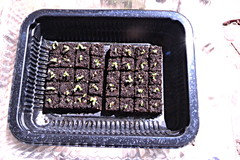
3) Keep temperatures between 70-85 degrees.
They were sprouting in an unheated workshop, temps 60-65 degrees.
They WERE dropped on the surface, left uncovered, and kept moist, but the rest of your protocol was not necessary.LoneJack Zn 6a, KC
7 years agoI agree Lazy_gardens. Way too complicated and un-necessary.
That's really good seed viability for 8 year old lettuce seed. I usually start noticing that lettuce seed germination rate tends to start to decline pretty fast after about 4 years. This year I got 50% germination rate on some Jericho romaine seed that had a germination test date in 2013. I didn't throw out the seed but I need to remember to go back and write a note on the packet to sow 3x the normal rate next year.
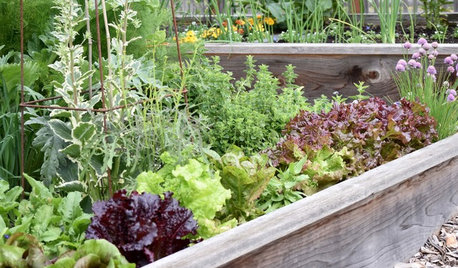
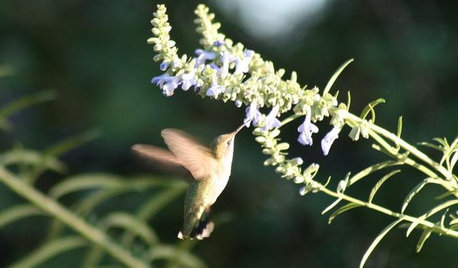
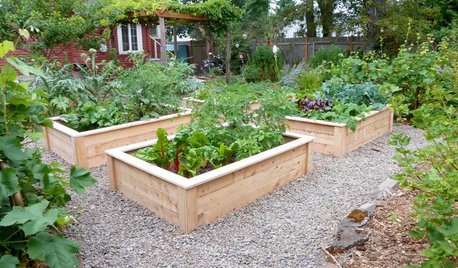

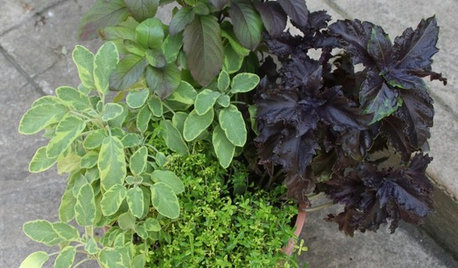


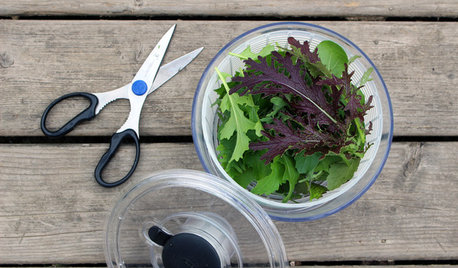
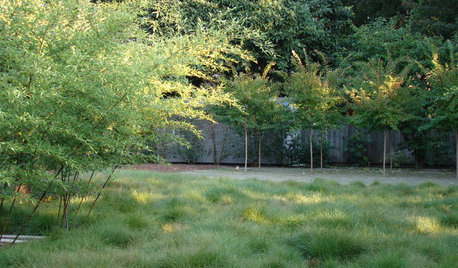
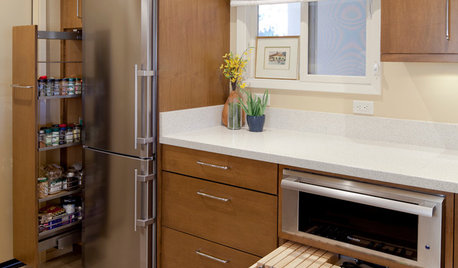






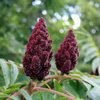
soulreaverOriginal Author